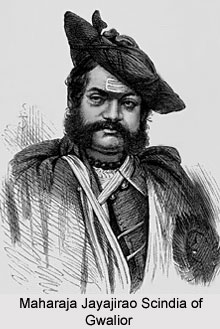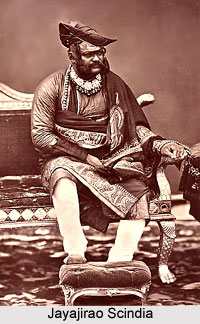 Maharaja Jayajirao Scindia was the ruling Maharaja of Gwalior state. He belonged to the Scindia dynasty and ruled over the territory from the year 1843 to 1886 under the rule of the British Empire in India. He was born on 19 January 1835, as Bhagirath Shinde, the son of Hanwant Rao. The previous ruler of the princely state of Gwalior, Jankojirao II, died in the year 1843 without an heir. As a result Tara Bai, his widow, adopted Bhagirath Rao. Consequently, Bhagirath Shinde succeeded the royal throne or gaddi of Gwalior state and adopted the name of Jayajirao Sindhia on 22 February 1843. As he was still a minor at the time, the maternal uncle of Jankojirao II, Mama Sahib, served as regent. After Jayajirao attained the age of majority, he was invested with full ruling powers.
Maharaja Jayajirao Scindia was the ruling Maharaja of Gwalior state. He belonged to the Scindia dynasty and ruled over the territory from the year 1843 to 1886 under the rule of the British Empire in India. He was born on 19 January 1835, as Bhagirath Shinde, the son of Hanwant Rao. The previous ruler of the princely state of Gwalior, Jankojirao II, died in the year 1843 without an heir. As a result Tara Bai, his widow, adopted Bhagirath Rao. Consequently, Bhagirath Shinde succeeded the royal throne or gaddi of Gwalior state and adopted the name of Jayajirao Sindhia on 22 February 1843. As he was still a minor at the time, the maternal uncle of Jankojirao II, Mama Sahib, served as regent. After Jayajirao attained the age of majority, he was invested with full ruling powers.
Later, the British East India Company appointed a Council of Regency that would operate under the advice of the political agent, also known as the Resident of British India.
Rule of Jayajirao Scindia
During the Great Revolt of 1857, Maharaja Jayajirao Scindia supported the British Government of India, even though his ancestors fought against them and were defeated. Following the advice of the British representative to Gwalior, Major Chartres Macpherson, and his minister Dinkar Rao, Jayajirao initially remained unbiased and neutral but later took side of the British administration, in spite of disorder and conflict among his royal troops and his subjects, who were determined to support the rebels.
In the year 1872, Maharaja Jayajirao Scindia of Gwalior state financially supported the establishment of the Agra Gwalior portion of the Great Indian Peninsular Railway. Moreover, in 1873, he contributed a huge amount for the construction of the Indore Neemuch section of the Rajputana Malwa railway. Later in 1882, the state of Gwalior ceded land for the Midland section of the Great Indian Peninsular Railway. During his reign over the region, several new structures and buildings were constructed, such as Daffrine Sarai, Gorkhi Dwar Gate, Victoriya Building, Kampoo Kothi and Jaivilas Mahal. Jayajirao Scindia reconstructed and renovated the Koteshwar Mandir and established around sixty nine Shiva temples through out the Gwalior state.
He also contributed lump sum amount for the restoration and reconstruction of the boundary wall of the Gwalior fort and the damaged portions of Johar Kund, Gujri Mahal and Man Mandir. In the year 1886, the Gwalior fort, Morar cantonment and few other villages that were held by the British forces from 1858, were exchanged for the city of Jhansi.
Personal Life of Jayajirao Scindia
Jayajirao Scindia, Maharaja of Gwalior, was married four times, first to Chimnabai Kadam in 1843 and later with Laxmibai Gujar in the year 1852. He was married to Babuibai Sawant in 1873, who became his third wife and his fourth wife was Sakhyabai. The eldest son of Jayajirao named Balwantrao Shinde, was born with his second wife Laxmibai Gujar. The Maharaja had another son named Madho Rao Scindia, with Sakhyabai, who was his fourth but only surviving son.
Maharaja Jayajirao Scindia died in the year 1886 at Gwalior. He was honoured with a personal salute of 21 guns. Madho Rao Scindia succeeded his father and ascended the throne of Gwalior as the new ruler.
Titles of Jayajirao Scindia
 The official full name of Jayajirao Scindia was General His Highness Ali Jah, Umdat ul Umara, Hisam us Sultanat, Mukhtar ul Mulk, Azim ul Iqtidar, Rafi us-Shan, Wala Shikoh, Muhtasham i-Dauran, Maharajadhiraj Maharaja Shrimant Sir Jayaji Rao Scindia Bahadur, Shrinath, Mansur i-Zaman, Fidvi i-Hazrat i-Malika i-Muazzama i-Rafi ud-Darja i-Inglistan Maharaja Scindia of Gwalior, GCB, GCSI, CIE, KIH.
The official full name of Jayajirao Scindia was General His Highness Ali Jah, Umdat ul Umara, Hisam us Sultanat, Mukhtar ul Mulk, Azim ul Iqtidar, Rafi us-Shan, Wala Shikoh, Muhtasham i-Dauran, Maharajadhiraj Maharaja Shrimant Sir Jayaji Rao Scindia Bahadur, Shrinath, Mansur i-Zaman, Fidvi i-Hazrat i-Malika i-Muazzama i-Rafi ud-Darja i-Inglistan Maharaja Scindia of Gwalior, GCB, GCSI, CIE, KIH.
He held several titles and styles during his reign over the state of Gwalior; these are discussed below-
* Shrimant Kumar Bhagirath Rao Scindia (1835- 1843)
* His Highness Ali Jah, Umdat ul-Umara, Hisam us-Sultanat, Mukhtar ul-Mulk, Maharajadhiraj Maharaja Shrimant Jayajirao Scindia Bahadur, Shrinath, Mansur i-Zaman, Maharaja Scindia of Gwalior (1843- 1845)
* His Highness Ali Jah, Umdat ul-Umara, Hisam us-Sultanat, Mukhtar ul-Mulk, Azim ul-Iqtidar, Rafi-us-Shan, Wala Shikoh, Muhtasham i-Dauran, Maharajadhiraj Maharaja Shrimant Jayajirao Scindia Bahadur, Shrinath, Mansur i-Zaman, Fidvi i-Hazrat i-Malika i-Muazzama i-Rafi ud-Darja i-Inglistan Maharaja Scindia of Gwalior (1845- 1861)
* His Highness Ali Jah, Umdat ul-Umara, Hisam us-Sultanat, Mukhtar ul-Mulk, Azim ul-Iqtidar, Rafi us-Shan, Wala Shikoh, Muhtasham-i-Dauran, Maharajadhiraj Maharaja Shrimant Sir Jayajirao Scindia Bahadur, Shrinath, Mansur i-Zaman, Fidvi i-Hazrat i-Malika i-Muazzama i-Rafi ud-Darja i-Inglistan Maharaja Scindia of Gwalior, KSI (1861- 1866)
* His Highness Ali Jah, Umdat ul-Umara, Hisam us-Sultanat, Mukhtar ul-Mulk, Azim ul-Iqtidar, Rafi us-Shan, Wala Shikoh, Muhtasham i-Dauran, Maharajadhiraj Maharaja Shrimant Sir Jayajirao Scindia Bahadur, Shrinath, Mansur i-Zaman, Fidvi i-Hazrat i-Malika i-Muazzama i-Rafi ud-Darja i-Inglistan Maharaja Scindia of Gwalior, GCSI (1866- 1877)
* General His Highness Ali Jah, Umdat ul-Umara, Hisam us-Sultanat, Mukhtar ul-Mulk, Azim ul-Iqtidar, Rafi us-Shan, Wala Shikoh, Muhtasham i-Dauran, Maharajadhiraj Maharaja Shrimant Sir Jayajirao Scindia Bahadur, Shrinath, Mansur i-Zaman, Fidvi i-Hazrat i-Malika i-Muazzama i-Rafi ud-Darja i-Inglistan Maharaja Scindia of Gwalior, GCB, GCSI, KIH (1877- 1878)
* General His Highness Ali Jah, Umdat ul-Umara, Hisam us-Sultanat, Mukhtar ul-Mulk, Azim ul-Iqtidar, Rafi us-Shan, Wala Shikoh, Muhtasham i-Dauran, Maharajadhiraj Maharaja Shrimant Sir Jayajirao Scindia Bahadur, Shrinath, Mansur i-Zaman, Fidvi i-Hazrat i-Malika i-Muazzama i-Rafi ud-Darja i-Inglistan Maharaja Scindia of Gwalior, GCB, GCSI, CIE, KIH (1878- 1886)
Honours of Jayajirao Scindia
Maharaja Jayajirao Scindia of Gwalior was appointed as a Knights Grand Commander of the Order of the Star of India (GCSI) in the year 1861. He was regarded as loyal friend of the British Government and his photo was published in the London press. Later in 1877 Jayajirao became a Counsellor of the Empress. Later he became a Knight Grand Cross of the Most Honourable Order of the Bath Knight Grand Cross (GCB) and was also appointed as a Companion of the Most Eminent Order of the Indian Empire (CIE).



















